— By Chris Gonzales, Freelance Science Writer, New York Sea Grant
Ecologist Provides Annual Update on Long Island's Challenges and Solutions
Stony Brook, NY, July 6, 2021 — Long Island is comprised of three major watersheds. — Long Island Sound, Peconic Estuary, and South Shore Estuary Reserve. Every activity that takes place on land—residential, industrial, and agricultural—influences our bays and only source of drinking water. Pollutants from land travel through the watersheds and reach our sole source aquifer and surface waters.
An expanding population translates to higher levels of nitrogen in these waters. On Long Island, onsite septic systems are the biggest source of nitrogen entering our watersheds, and many studies now confirm this.
This excess of nitrogen leads to harmful algal blooms (HABs) and fish kills. As a result, many bodies of water on the island are “impaired” in some way. Increased nitrogen also makes HABs more intense or more toxic. Furthermore, recent studies indicate that a high rate of nitrate in the drinking water amounts to a public health threat.
“Warming, acidification, deoxygenation, and HABs are intensifying to the detriment of fisheries and ecosystems,” said Dr. Christopher Gobler, an ecologist at Stony Brook University’s School of Marine and Atmospheric Sciences. He delivered the annual “State of the Bays” address earlier this spring, in which he detailed current threats to the region’s ecosystems and coastal communities, but also gave reasons for hope.
A Focus on Blooms
Long Island’s Suffolk County has the greatest number of incidents of blue-green algae blooms in New York State and has twice the frequency of any other NYS county on the monitoring list.
Blue-green algae blooms in inland freshwater lakes are caused by Microcystis, a potent gastrointestinal toxin. During the summer of 2020, blue-green algae blooms have led to die-offs of hundreds of endangered elephants in Botswana. Thus, not only are Microcystis a global problem, but their toxins are also potent enough to be a significant threat to large mammals. This toxin is unsurprisingly also harmful to small animals such as pet dogs that like to enjoy the waters around Long Island.
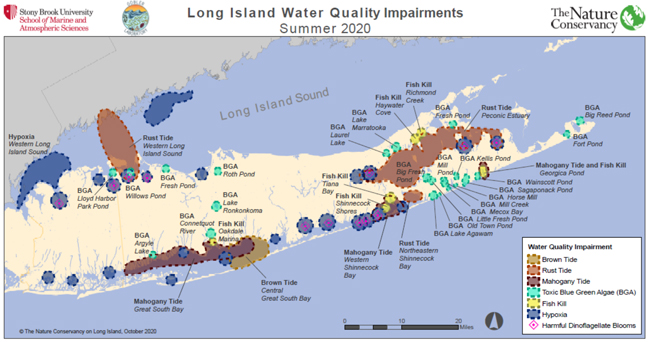
Credit: Christopher Gobler, SoMAS, Stony Brook University.
Other blooms that plague Long Island waters (as featured above in the summer 2020 map) include mahogany tide, rust tide, and brown tide – all of which bring negative impacts.
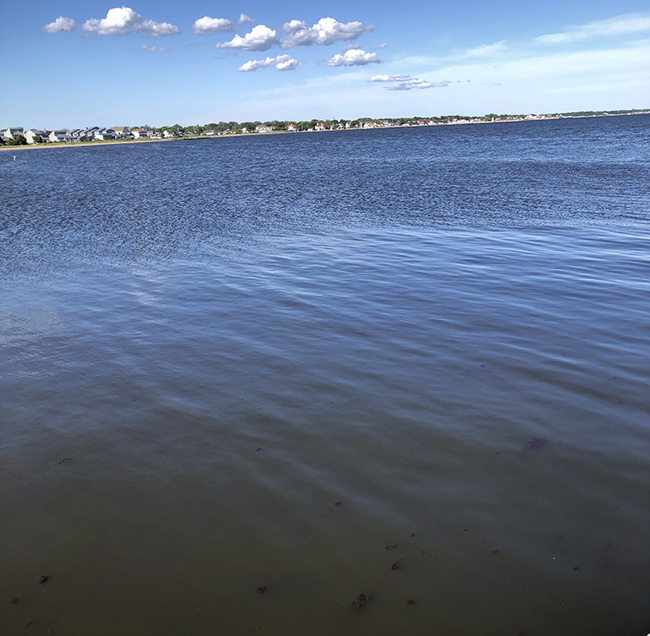
Credit: Christopher Gobler, SoMAS, Stony Brook University.
Just as we were publishing this story, the Gobler Laboratory began monitoring a brown tide in the waters of Long Island's Great South Bay near Patchogue. Caused by the Aureococcus anophagefferens alga, this HAB (seen above on June 23, 2021) is highly damaging to marine life, especially eelgrass that fish and shellfish depend on for habitat. For more, see the SBU School of Marine and Atmospheric Sciences news item, "Harmful Brown Tide Erupts Across Great South Bay."
Harmful Seaweed
Dasysiphonia japonica, is an invasive seaweed that can release hydrogen sulfide gas and thus is both a human health threat and a threat to aquatic life. Originally from the Pacific Ocean, this seaweed (which was also highlighted in 2020’s State of the Bays) invaded Europe at the end of the 20th century and has since invaded the northeast U.S. Gobler’s lab recently discovered this seaweed has invaded the south shore estuaries of Long Island and is promoted by high nitrogen and high levels of carbon dioxide.
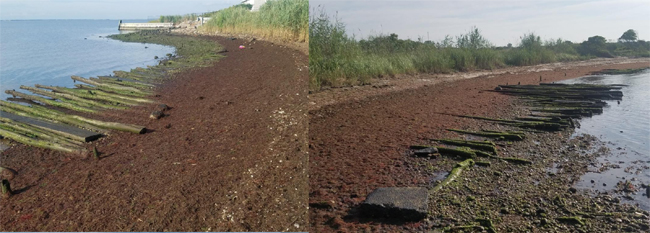
Dasysiphonia japonica, a dangerous type of seaweed, can cause health problems including serious lung irritation. It releases hydrogen sulfide gas when it decays. Credit: Christopher Gobler, SoMAS, Stony Brook University.
The Gobler Lab remains on the lookout for this HAB and other water quality impairments; they are currently monitoring 30 locations on Long Island for potential trouble, including harmful algae, poor oxygen levels, acidity levels, and unusual temperature fluctuations.
Each year, throughout the summer, the findings are broadcast on the News 12 weather forecast, published in Newsday, and presented in other local media.
Current and Future Conditions
“Humans are driving climate and environmental conditions,” Gobler says. We’re in a new era called the Anthropocene, where humans are having an outsized effect on the environment and climate. He poses a metaphor called the “Four Horsemen of the Ocean Anthropocene Apocalypse.” With ocean warming, hypoxia, acidification, and HABs representing the Horsemen as they are all on the increase.
Gobler notes, “There are no local or regional options to mitigate the global rise in temperatures nor carbon dioxide. Thus, our primary tool to lessen the intensity of HABs, hypoxia, and coastal acidification is the mitigation of nitrogen.”
Gobler’s lab and the New York State Center for Clean Water Technology (CCWT) are currently conducting research in several promising areas. Septic system upgrades are a key part of the plan for Suffolk County’s Subwatersheds Wastewater Plan. Technologies such as nitrogen-removing biofilters (NRBs) that have been developed by CCWT will significantly reduce nitrogen seepage into groundwater and coastal waters.
Likewise, seaweeds like sugar kelp also offer hope. These aquatic plants work to take nitrogen and carbon dioxide out of the water. Furthermore, saxitoxin, a poison produced in certain HABs, is reduced by a type of kelp. Among other research, Gobler’s lab is experimenting with converting seaweeds into locally-sourced fertilizer.
Nitrogen pollution has become a serious, recurring problem. New York Sea Grant and Suffolk County Department of Health Services announced a year ago the release of the Suspicious Marine HAB reporting form: www.nyseagrant.org/reportHABs.
“We are urging people who visit the coast—anglers, boaters, beach users, and others—to report suspicious algae, by using the online reporting tool,” said Antoinette Clemetson, New York Sea Grant’s marine fisheries specialist. This tool was created to help document HABs and inform the public of their occurrences.
In Photos: Studying and Combating HABs
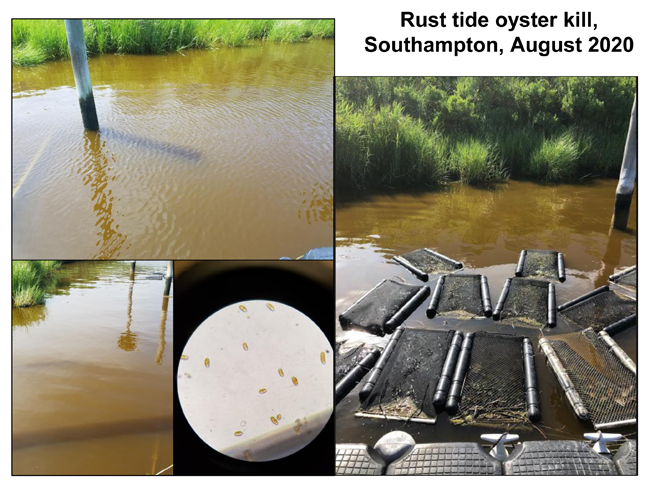
Rust tide (Cochlodinium spp.) oyster kill, Southampton, August 2020. Credit: Christopher Gobler, SoMAS, Stony Brook University.
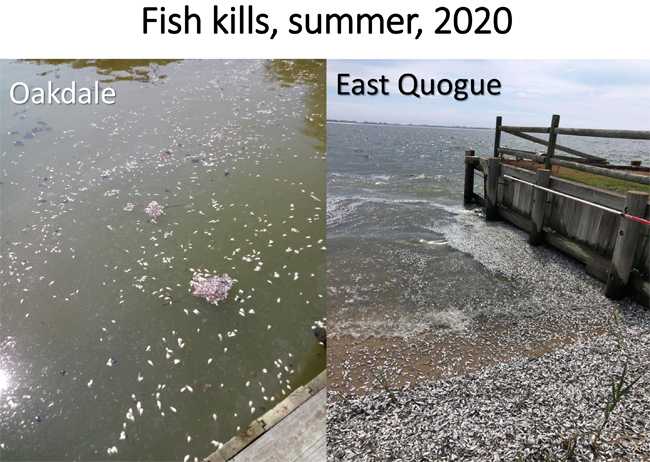
Fish kills, summer, 2020. Credit: Christopher Gobler, SoMAS, Stony Brook University.
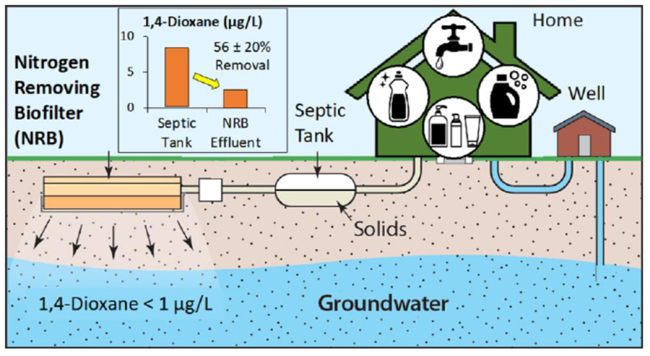
Schematic of nitrogen-removing biofilters. Credit: Christopher Gobler, SoMAS, Stony Brook University.
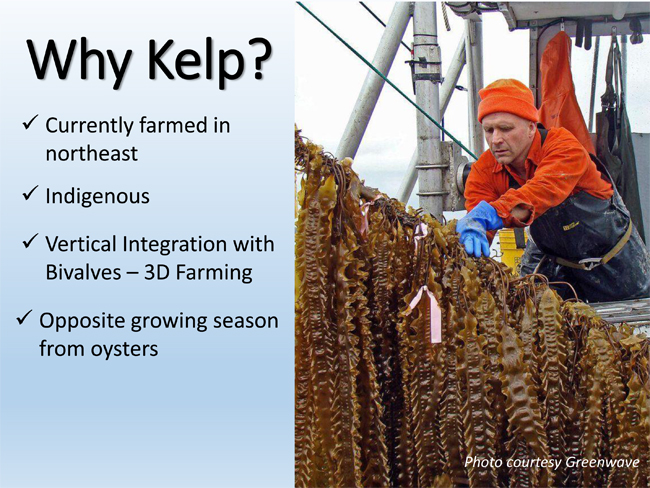
A farmer tends to cultivated seaweed. Credit: GreenWave.
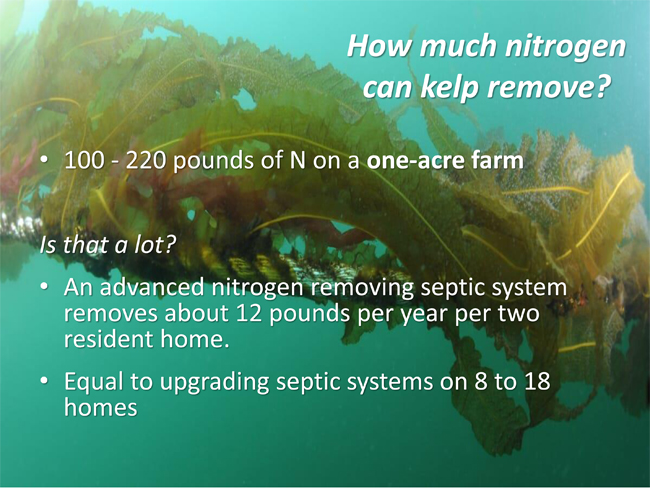
How much nitrogen can kelp remove? Credit: Christopher Gobler, SoMAS, Stony Brook University.
More Info: New York Sea Grant
New York Sea Grant (NYSG), a cooperative program of Cornell University
and the State University of New York (SUNY), is one of 34 university-based
programs under the National Oceanic and Atmospheric Administration’s
National Sea Grant College Program.
Since 1971, NYSG has represented a statewide network of integrated
research, education and extension services promoting coastal community
economic vitality, environmental sustainability and citizen awareness
and understanding about the State’s marine and Great Lakes resources.
Through NYSG’s efforts, the combined talents of university scientists
and extension specialists help develop and transfer science-based
information to many coastal user groups—businesses and industries,
federal, state and local government decision-makers and agency managers,
educators, the media and the interested public.
The program maintains Great Lakes offices at Cornell University, SUNY
Buffalo, SUNY Oswego and the Wayne County Cooperative Extension office
in Newark. In the State's marine waters, NYSG has offices at Stony Brook
University in Long Island, Brooklyn College and Cornell Cooperative
Extension in NYC and Kingston in the Hudson Valley.
For updates on Sea Grant activities: www.nyseagrant.org has RSS, Facebook, Twitter, Instagram, and YouTube links. NYSG offers a free e-list sign up via www.nyseagrant.org/nycoastlines for its flagship publication, NY Coastlines/Currents, which is published quarterly.